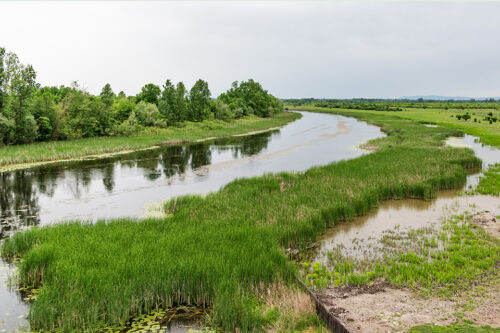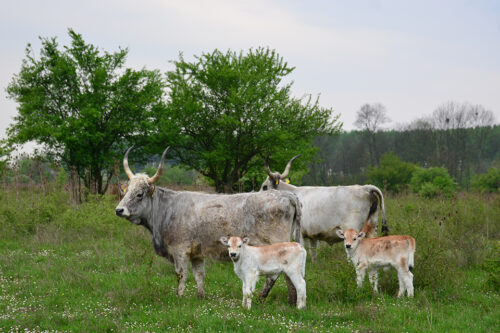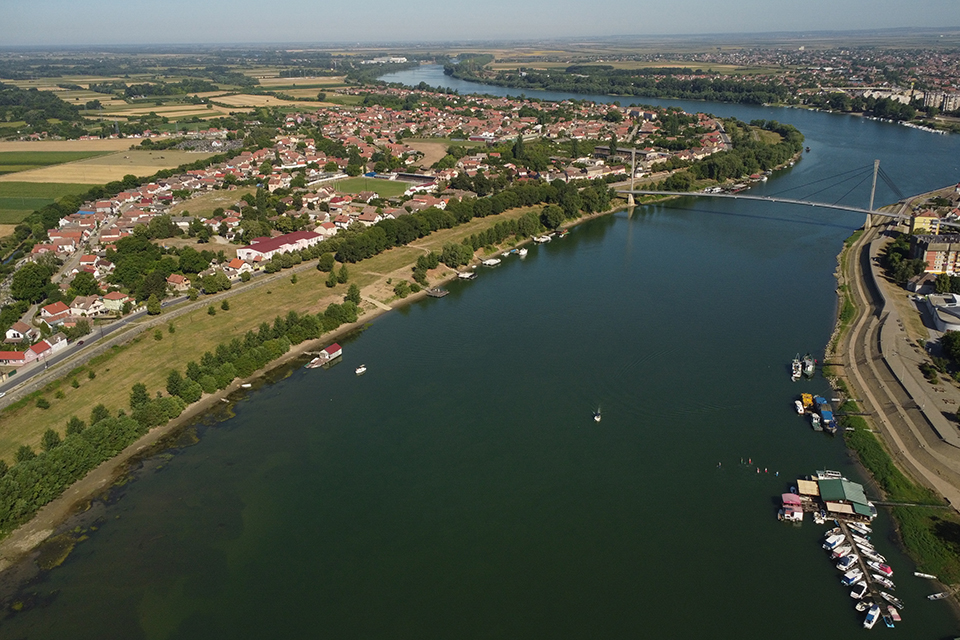Roman Sirmium is located beneath modern day Sremska Mitrovica on the River Sava. Once a major Roman city, it was destroyed by the Avars. New book recounts the story of a local saint, long forgotten
 In AD 294, Sirmium was proclaimed one of the four capitals of the Roman Empire and allotted to the emperor Galerius. Sirmium was situated near the river Sava, and the name, which means “flow, flowing water, wetland,” probably derives from this position. The Sava runs through Slovenia, Croatia, Bosnia, and Northern Serbia before feeding into the Danube.
In AD 294, Sirmium was proclaimed one of the four capitals of the Roman Empire and allotted to the emperor Galerius. Sirmium was situated near the river Sava, and the name, which means “flow, flowing water, wetland,” probably derives from this position. The Sava runs through Slovenia, Croatia, Bosnia, and Northern Serbia before feeding into the Danube.
Sirmium boasted an imperial palace, a horse-racing arena or hippodrome, a sporting arena, and a theater. Two bridges crossed the river. Additionally, the city sported numerous baths, villas, and public palaces. Glued to its important status were the silver mines in the Dinaric Alps and the mint established in the city.
Excavations have uncovered the remains of a magnificent imperial palace built with imported luxurious materials from the whole of the Roman Empire, such as Egyptian red and green porphyry and Tunisian marble. Also, the temple of Jupiter appears to have been an impressive edifice holding more than eighty altars. Finally, the city appears to have held eight churches. The city lies beneath modern-day Sremska Mitrovica, and excavations connected with building projects continue to yield spectacular finds.
From this period dates the imperial villa located at Glac, which might have been the site of the palace of the Roman Emperor Maximian Herculius.
Already by the third century, the city housed a Christian community, and from c. 300, the bishop at Sirmium acted as metropolitan for the Pannonian bishops. The first known bishop was Irenaeus of Sirmium, who was martyred together with St. Dimitrius during the Diocletian persecutions in AD 304 (see below).
The Christian Cemeteries in Sirmium have been shown to hold numerous Greek inscriptions. Also, the city appears to have been a hotspot for theological debates in the early church, some of which played out in both Latin and Greek. Thus, in 351, the bishop, Photinus, published some heretical writings in both Latin and Greek. According to these, Christ was not divine, and the Logos did not exist before conception. His teachings were anathematized and led to his exile, until he was recalled by Julian the Apostate. After the ascension of Valentinian, Photinus was once more expelled.
In AD 364, the city housed the meeting between Valentinian and Valens, which divided the Empire in two. After that, Roman emperors declined to invest in the city, which was located right at the border. The dilapidation of the walls led to a siege by the Sarmatians. At the end of the 4th century, and later, Sirmium came under the control of the Goths, to be once again reannexed to the East Roman Empire. In AD 441, the Huns conquered the city, leaving it to the warring factions and tribes until the Ostrogoths, the Gepids, and Byzantium retook the city. Finally, in 586, the Pannonian Avars conquered and destroyed the city. The last known mention of a bishop dates to AD 594, after which the sources are silent until the 10th century.
The Surrounding Landscape

In the Roman province of Pannonia Secunda, the area from the Fruška Gora mountains to the north, and the Jerez river on the south belonged to the catchment area of Sirmium.
Today, the region is thoroughly drained and cultivated except to the north, and sheep are now virtually absent. However, although draining was initiated in the 18th century, a million sheep still roamed the countryside up until WW2, exploiting the marshy and wet surroundings in the lowland and dry summer pastures in the mountains.
Recent surveys of this area covering more than 700 km2 in the surrounding catchment area of the river Sava have yielded precious information on this landscape organized around large latifundia operating a system of transhumance to the north and likely specialized in sheep and wool production. Extraordinarily, we know that in the 420s, the region around Sirmium housed two of the seventeen imperial weaving houses in the West, which were listed in the Notitia Dignitatum.
We don’t know the exact size of these institutions. Nevertheless, we are able to calculate the (wo)manpower needed to operate the provision of outfits for the soldiers, which the Roman state was responsible for providing. In the reign of Diocletian, two legions with 12000 men were posted in Pannonia. Each soldier needed at least a new tunic, a new set of undergarments, and a sagum (cape/blanket) each year. Some historians estimate that two outfits were the norm. And yet, Cato estimated that slaves needed a new set only every other year. On the other hand, Cato’s estimate of the material needed – 4.33 m2 – was probably also at the low end. Soldiers also needed a sagum – cape or blanket – as well as scarves and underwear. A reasonable estimate would be at least 8-10 m2 a year. This would entail the production of between 80-100,000 m2 per year. We know from experimental archaeology carried out at the Viking Ship Museum in Denmark that it involved approximately twenty – thirty days to prepare the wool, spin the yarn, and weave one m2 of cloth for a sail. Hence, the number of people needed to produce so much cloth for outfitting the legions would be at least 6-8000 people. Likely, the soldierly outfits were produced at the homes of the soldiers by their families and paid for with money. However, the organization of this production and output might have been organized in the region around Sirmium and by the imperial weaving houses. This might have been their main role apart from producing textiles for the elite administration.
The Zasavica Special Nature Reserve

To experience the ancient marshy landscape, a visit to Zasavica nature reserve next to a tributary to the Sava is worth a detour. The Zasavica is classified as IUCN category IV and is located to the west of Sremska and Maèvanska Mitrovica, built on top of the Roman city.
The area covers 1850 ha of marshy pasture, of which 675 are strictly protected. The area hosting 600 plants, 216 bird, 20 fish, and 65 mammal species. Of the 27 amphibians, four are strictly protected. The Zasavica is designated as Ramsar. Though the area also houses a small rural museum and a farm which is home to ancient breeds such as the Balkan Donkey, the Mangulica pig, the Podolian cattle, and the local mountain horse, the nature reserve invites the visitor to experience the old marshy landscape by taking a boat trip and its rich nature. As the landscape is somewhat manicured, less intensive grazing and thus more rewilding might probably produce a better balance in terms of the landscape. Yet, it is well worth a visit.
A Spectre in Modern Day Sirmium – St. Irenaeus
During the last great persecution of Christians in the early fourth century, Irenaeus of Sirmium, together with other staunch supporters, was sentenced to death due to their resistance against sacrificing to the Roman Empire. According to his vita, he was condemned to drowning, and The Pons Basentius was chosen as the scene for the execution, which took place in March 304.
As told in some versions of his vita, the saint demanded to also be beheaded. In the end, his remains were said to be dumped into the river. The next day, his deacon, Demetrius, was also said to be martyred together with other prominent Christians living in what at that time was already a sizable Christian Community.
Between 1966-77, archaeologists discovered a martyrium in a Christian Cemetery located on the left bank of the river and to the north. Built as a small church with one nave and an apse, the archaeologists dated the building to the 4th – 6th centuries. The excavation report, recently published (Popović 2023), shows the remains of a ground-plan of a basilica and a funerary inscription mentioning the saint (basilica domini nostri Erenei). Further, the archaeologists found another 4th-century site located 150 meters from the right bank of the river near the pons Basentius. Here, the archaeologists uncovered another late antique necropolis and a martyrium, with three medieval churches, one on top of the other. The site is known from written charters in the 14th century identifying it as dedicated to St. Irenaeus.
Later, after the Avars destroyed the city, these two martyria were abandoned. During the 5th and 6th centuries, the city fell into complete disarray and it appears the names of the saints were forgotten until they were “resurrected” in the 10th century on the right bank as part of the missionary efforts launched from Bavaria and Byzantium. Apparently, St. Irenaeus and his martyred fellows were “reinvented” during this period; hence the upsurge in the number of manuscripts recounting the stories of their death. Thus, the first new church from the 10th century was built in the Frankish manner, while the Byzantine reconstruction might be dated to the beginning of the 11th century.
In a recent twist, Irenaeus of Sirmium was once again resurrected. Between 1990 and 1993, a bridge was built between the two parts of the town, Sremska on the left bank and Maèvanska on the right. With Sremska originally located near the border to Bosnia and Maèvanska in Serbia, and both in Vojvodina, the bridge – which was initially planned as a local piece of infrastructure – came to be caught up in the nationalistic agenda of Serbia in the 90s.
Marijana Vukovic, who has explored the history of the new bridge, found that this project occurred at the same time as Miloševic appeared on the Serbian scene. The bridge was inaugurated on the 28th of June 1993, the official remembrance date of the Battle of Kosovo 1389. At this event, Miloševic was one of the first people on the bridge, exclaiming his satisfaction with the linking up of Serbia with the autonomous province of Vojvodina, which Miloševic had incorporated into Serbia in 1989.
At the same time, it appears the name of the bridge was decided to be named after St. Irenaeus of Sirmium. This act was followed by a renaming of 39 streets, one of which was Irenaeus. Finally, a new church was erected, dedicated to the Sirmian Martyrs. This church was built between 1994-98 in Sremska Mitrovica in a district called “Little Bosnia.” Thus, the church was begun in the final hours of the civil war. Obviously, the church was intended to commemorate not just the ancient martyrs but also the “modern” (Serbian) ones spanning those who died during 1940-45 and in the 1990s. Thus, in a final twist of the tale, St. Irenaeus was refashioned as a Serbian saint.
New Book
A new book tells this story of Irenaeus of Sirmium and the invention of the many traditions surrounding his martyrium from the 4th – 21st century, while carefully curating the many versions of the vita in Latin, Greek, Old Slavonic, Georgian, and Armenian.
The study of hagiographies has generally been focused on the more prominent saints of late antiquity and the Middle Ages who inspired significant and long-lasting veneration. However, this has caused many less well-known saints to be pushed aside and forgotten. This book is a study into one such saint, Irenaeus. His short-lived cult, his feast day, and the account of his martyrdom (which had been translated into so many languages that the original is complicated if not impossible to identify) had all been forgotten during the Middle Ages. This book examines Irenaeus of Sirmium’s life, cult, sainthood, and eventual disappearance from the memory of medieval Christendom, in the context of a wider study on the memory of those less well-known saints who, like Irenaeus, became neglected and eventually forgotten.
“Irenaeus of Sirmium and His Story in the Medieval East and West” will be of interest to scholars and students alike interested in hagiography, medieval literature and history, as well as all those interested in the religious history of Byzantium, medieval Europe, and the Slavic world.

